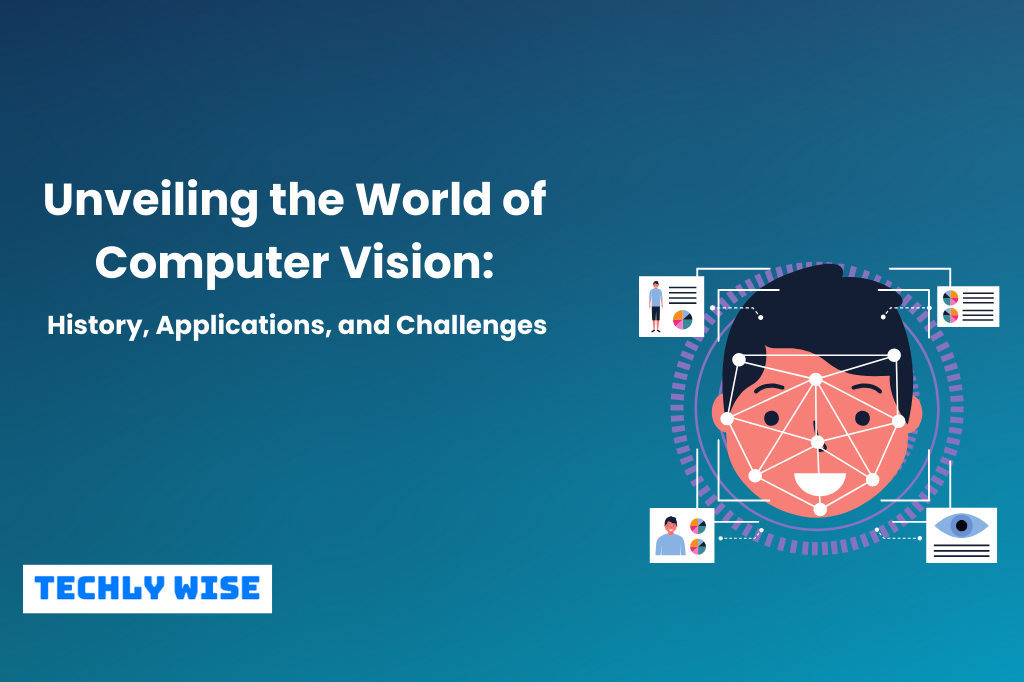
Artificial intelligence has a subfield called computer vision, which enables computers and systems to extract information from digital films, photographs, and other visual inputs and to carry out operations or offer suggestions based on that information.
Computer vision gives machines the ability to perceive, understand, and observe, much like artificial intelligence gives them the ability to think.
The long history of human eyesight gives it an advantage over computer vision. The human sight has the advantage of learning how to differentiate between items, gauge their distance from the viewer, assess whether they are moving, and assess whether an image is accurate throughout a lifetime.
In contrast to human vision, which requires the retina, optic nerves, and visual cortex, computer vision teaches robots to execute these tasks in much less time with the use of cameras, data, and algorithms.
Since it can analyze thousands of products or processes per minute while finding invisible flaws or problems, a system trained to inspect products or monitor a manufacturing asset can quickly outperform people.
The History of Computer Vision
For almost 60 years, scientists and engineers have worked to create systems that would enable machines to see and comprehend visual information.
Neurophysiologists began their first experiment in 1959 by exposing a cat to a variety of images in an effort to correlate a brain response. They found that it responded to hard edges or lines initially, and scientifically this meant that simple shapes like straight edges are where picture processing starts.
The first computer image scanning technology, which allowed computers to digitize and acquire images, was created about the same time. The ability of computers to convert two-dimensional images into three-dimensional shapes in 1963 marked the achievement of another major milestone.
The 1960s saw the emergence of AI as a field of research and the start of the AI effort to address the issue of human eyesight. Optical character recognition technology, which could read text printed in any font or typeface, was first introduced in 1974.
Similarly to this, intelligent character recognition (ICR) could use neural networks to decode handwritten text. Since then, OCR and ICR have made their way into a variety of popular applications. Including the processing of documents and invoices, the identification of license plates, machine translation, mobile payments, and more.
David Marr, a neuroscientist, devised algorithms for computers to recognize edges, curves, corners, and other basic structures in 1982 and showed that vision works hierarchically.
In parallel, Kunihiko Fukushima, a computer scientist, created a network of cells that could recognize patterns. Convolutional layers in a neural network were part of the Neocognitron network.
In 2000, object identification became the primary area of research, and the first real-time face recognition applications appeared in 2001. It has millions of annotated images from a thousand different object classes and served as the basis for the current generation of CNNs and deep learning models.
In 2012, a team from the University of Toronto joined CNN in a contest for image identification. The AlexNet model drastically decreased the rate of error in picture recognition. Error rates have now decreased to just a few percent since this discovery.
Why Is Computer Vision So Important?
The most technologically sophisticated area of artificial intelligence in the current era is computer vision. And over the next five to ten years, this will reach its peak and have a huge commercial value.
Even today, computer vision provides applications in every sector of the economy, such as agriculture, construction, retail, manufacturing, insurance, logistics, healthcare, smart cities, and many more.
Component of a Computer Vision
In a deep learning computer vision system nowadays, the following elements are often present:
Image acquisition: A camera’s or a video file’s video stream must be captured frame by frame. Pre-processing: To enhance algorithm performance, the image is optimized or cropped. Deep learning algorithms are used for object recognition and classification algorithms. Communication: Uploading data to the cloud where it will be stored in a database and displayed in dashboards.
Working on Computer Vision
Data is essential for computer vision. It performs data analysis repeatedly until it can identify objects and recognize images. Two key technologies, convolutional neural networks (CNN) and deep learning, a type of machine learning, accomplish this.
For a computer to learn about the context of visual input, machine learning employs algorithmic models. Algorithms enable the machine to learn on its own rather than requiring programming to recognize an image.
By dissecting images into pixels with labels or tags, a CNN aids a machine learning or deep learning model’s ability to “look.” Convolutions are mathematical operations on two functions that result in a third function. It performs convolutions using the labels and forecasts what it is “seeing”.
The neural network performs convolutions and continuously assesses the precision of its predictions up until they begin to come true. Then, it recognizes or views images similarly to how people do.
A CNN first recognizes sharp edges and basic shapes, much like a human does when attempting to make out an image from a distance, and then fills in the blanks as it makes predictions.
Computer Vision Applications
Among the applications are:
Self-Driving Cars
Autonomous vehicles can comprehend their surroundings by using computer vision. The autonomous vehicle can then drive itself on roads and avoid obstacles, and highways, and securely transport its occupants to their destination.
Mixed and Augmented Reality
Computer vision is a key component of augmented reality, which enables digital content to be superimposed or embedded into real-world situations using devices like smartphones and wearable technology. Augmented reality apps use computer vision algorithms to identify surfaces like ceilings, tabletops, and floors to accurately construct depth and proportions and position virtual objects in the real environment.
Healthcare
One of the many uses for computer vision algorithms is automating the process of searching for cancerous moles on a person’s skin or finding signs in an MRI image or X-ray.
Recognition of Faces
Programs that use computer vision to identify people in photos, such as facial recognition software, significantly rely on this area of research. Face recognition is becoming more common in consumer gadgets to confirm the identification of users.
Social networking programs employ facial recognition to identify users and tag them. Law enforcement uses face recognition software to identify criminals in surveillance films for the same reason.
Computer Vision Algorithms
Many techniques used to recognize objects in digital photographs and extract high-dimensional data from the physical world for usage as numeric or symbolic data encompass computer vision algorithms. Recognizing objects in images involves a variety of other computer vision methods.
Common examples include:
Classification of Objects:
What is the principal classification of the object seen in this picture?
Object Identification:
What kind of object is seen in this picture?
Object Segmentation:
Which pixels in the picture make up the object?
Verification of objects:
Is the item captured in the image?
Object Detection:
What can be seen in the picture?
Recognition of Objects:
What do the things in this picture look like, and where are they?
Landmark Object Detection:
What stands out about the subject of this picture?
Advantages of Computer Vision
There are the following Advantages:
Improved Goods and Services
Computer vision systems that have undergone extensive training will never be wrong. Faster delivery of high-quality goods and services will follow.
Cost-cutting
Computer vision will eliminate the need for subpar goods and services, saving businesses the expense of rectifying their problematic processes.
Enhanced Online Retailing
To assist in directing the search to the appropriate product, a product like a rucksack may be accompanied by several keywords like “blue,” “bag,” “cotton,” or “polyester,” to mention a few. Although it is not the most effective approach, it is what we have been using for years.
Computer vision evaluates the real physical properties of each image rather than relying on tags to cycle through several product styles. Customers will be able to search using photographs to identify styles that are close to what they’re looking for thanks to this program.
Product and Content Discovery in the Real World
Concepts from all around the internet and even the actual world may link thanks to the power of computer vision, as Pinterest Lens shows. You can start a search that brings your interests to your door with only one picture of anything you choose.
Services like Pinterest Lens and Facebook may provide you with that experience, whether you’re trying to find a similar product to buy or fresh ideas that are similar to what you’re looking for.
Store Experiences at Seamless
This idea has previously been fully illustrated by Amazon. Long lineups, interacting with cashiers, and holding your wallet when it’s time to pay are things of the past. Using computer vision to enhance the store experience, you may shop in a seamless, effective environment. Convenience is crucial in this situation, for both the client and the business.
Augmented Reality
The idea behind augmented reality is to add information from the internet and our phones on top of the reality we experience every day. Imagine you wanted to purchase a new bike, for instance. Instead of having to spend time looking up information on that bike, computer vision may employ augmented reality to instantly display facts, reviews, and metrics about the item. A lot of other businesses, including Apple, are investigating the possibilities and the promise that augmented reality holds.
Disadvantages of Computer Vision
Computer vision systems are not exempt from problems because no technology is perfect. The following are some of computer vision’s drawbacks:
Regular monitoring is necessary.
A computer vision system’s malfunction or technical issue could cost businesses a lot of money. To manage and evaluate these technologies, organizations must have a specialized team on staff.
Challenges of Computer Vision
It’s surprisingly difficult to build a machine that can see at a human level, and this difficulty is not just related to the difficulties of using computers to accomplish this. We still have a lot to discover about how human eyesight works.
One must understand not only how different receptors, such as the eye, function but also how the brain interprets what it sees to completely comprehend the biological vision.




